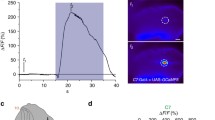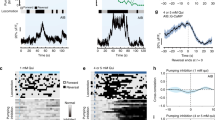Abstract
How does the nervous system encode environmental stimuli as sensory experiences? Both the type (visual, olfactory, gustatory, mechanical or auditory) and the quality of a stimulus (spatial position, intensity or frequency) are represented as a neural code. Here we undertake a genetic analysis of sensory modality coding in Caenorhabditis elegans. The ASH sensory neurons respond to two distinct sensory stimuli (nose touch and osmotic stimuli). A mutation in the glr-1 (glutamate receptor) gene eliminates the response to nose touch but not to osmotic repellents. The predicted GLR-1 protein is roughly 40% identical to mammalian AMPA-class glutamate receptor (GluR) subunits. Analysis of glr-1 expression and genetic mosaics indicates that GLR-1 receptors act in synaptic targets of the ASH neurons. We propose that discrimination between the ASH sensory modalities arises from differential release of ASH neurotransmitters in response to different stimuli.
Similar content being viewed by others
References
Bargmann, C. Cell 74, 515–527 (1993).
Hodgkin, J. Genetics 103, 43–64 (1983).
Riddle, D. L. in The Nematode C. elegans (ed. Wood, W. B.) 393–412 (Cold Spring Harbor Laboratory, Cold Spring Harbor, New York, 1988).
Sulston, J. et al. Nature 356, 37–41 (1992).
Sommer, B. et al. Science 249, 1580–1585 (1990).
Chalfie, M., Tu, Y., Euskirchen, G., Ward, W. & Prasher, D. Science 263, 802–805 (1994).
Chalfie, M. et al. J. Neurosci. 5, 956–964 (1985).
Way, J. C. & Chalfie, M. Genes Dev. 3, 1823–1833 (1989).
White, J. G., Southgate, E., Thomson, J. N. & Brenner, S. Phil. Trans. R. Soc. Lond. 314, 1–340 (1986).
Sulston, J. E., Schierenberg, E., White, J. G. & Thomson, J. N. Devl Biol. 100, 64–119 (1983).
Peng, Y. & Zucker, R. S. Neuron 10, 465–473 (1993).
DeVries, S. H. & Baylor, D. A. Cell/Neuron 72/10, 139–149 (1993).
Whim, M. D. & Lloyd, P. E. J. Neurosci. 14, 4244–4251 (1994).
Kaplari, J. M. & Horvitz, H. R. Proc. natn. Acad. Sci. U.S.A. 90, 2227–2231 (1993).
Bargmann, C. I., Thomas, J. H. & Horvitz, H. R. Cold Spring Harbor Symp. quant. Biol. 55, 529–538 (1990).
Herman, R. & Hedgecock, E. Nature 348, 169–171 (1990).
Hollmann, M., Maron, C. & Heinemann, S. Neuron 13, 1331–1343 (1994).
Huang, L., Tzou, P. & Sternberg, P. Molec. Biol. Cell 5, 395–412 (1994).
Author information
Authors and Affiliations
Rights and permissions
About this article
Cite this article
Hart, A., Sims, S. & Kaplan, J. Synaptic code for sensory modalities revealed by C. elegans GLR-1 glutamate receptor. Nature 378, 82–85 (1995). https://doi.org/10.1038/378082a0
Received:
Accepted:
Issue Date:
DOI: https://doi.org/10.1038/378082a0
- Springer Nature Limited
This article is cited by
-
Molecular and circuit mechanisms underlying avoidance of rapid cooling stimuli in C. elegans
Nature Communications (2024)
-
A general pattern of non-spiking neuron dynamics under the effect of potassium and calcium channel modifications
Journal of Computational Neuroscience (2023)
-
What if worms were sentient? Insights into subjective experience from the Caenorhabditis elegans connectome
Biology & Philosophy (2023)
-
The transcription factor unc-130/FOXD3/4 contributes to the biphasic calcium response required to optimize avoidance behavior
Scientific Reports (2022)
-
Opponent vesicular transporters regulate the strength of glutamatergic neurotransmission in a C. elegans sensory circuit
Nature Communications (2021)





